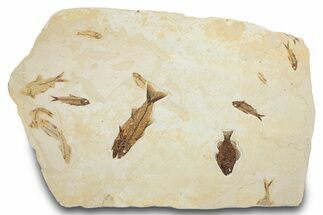This Specimen has been sold.
5" Priscacara Fossil Fish On Large Plate
Here is a beautiful example of the fossil fish Cockerellites liops centered on a large plate of matrix. It comes from the famed 18 inch layer of the Green River Formation which produces darkly preserved and very detailed fish fossils. The fish is 5 inches long on a solid 15x14 inch slab of matrix. This slab would be great for framing or hanging on a wall.
Note: We can trim the slab down to a custom size upon request at no charge. This may also substantially reduce the shipping costs.
Note: We can trim the slab down to a custom size upon request at no charge. This may also substantially reduce the shipping costs.
Cockerellites liops is a species of extinct temperate bass found in the Eocene aged Green River Formation of Wyoming. It is characterized by a sunfish-like body and its stout dorsal and anal spines. It was originally placed in the Priscacara genus but was moved to the newly created genus Cockerellites by D. Jordan and H. Hanibal in 1923. There is still some debate among researchers about whether this new genus is valid.
Cockerellites is found in large numbers in mid-lake deposits, representing 5 to 20 percent of the fish unearthed, depending on the layer. It is considerably rarer in shoreline deposits, representing only 1 to 2 percent of the fish found. Because of this, Cockerellites is thought to have been a schooling fish. Fossils have been found at a maximum size of about six inches, but they rarely exceed five inches in length.
At first glance, Cockerellites liops has a very similar appearance to the rarer species Priscacara. Size can often be used as a differentiator, since Cockerellites did not exceed 6 inches while Priscacara serrata is typically found in excess of 6 inches. Cockerellites also has more dorsal and anal fin rays than Priscacara and a much smaller mouth.
Cockerellites is found in large numbers in mid-lake deposits, representing 5 to 20 percent of the fish unearthed, depending on the layer. It is considerably rarer in shoreline deposits, representing only 1 to 2 percent of the fish found. Because of this, Cockerellites is thought to have been a schooling fish. Fossils have been found at a maximum size of about six inches, but they rarely exceed five inches in length.
At first glance, Cockerellites liops has a very similar appearance to the rarer species Priscacara. Size can often be used as a differentiator, since Cockerellites did not exceed 6 inches while Priscacara serrata is typically found in excess of 6 inches. Cockerellites also has more dorsal and anal fin rays than Priscacara and a much smaller mouth.
SPECIES
Cockerellites liops
LOCATION
Kemmerer, Wyoming
FORMATION
Green River Formation
SIZE
5", Matrix 15x14"
CATEGORY
SUB CATEGORY
ITEM
#7514
We guarantee the authenticity of all of our specimens.
 Reviews
Reviews














